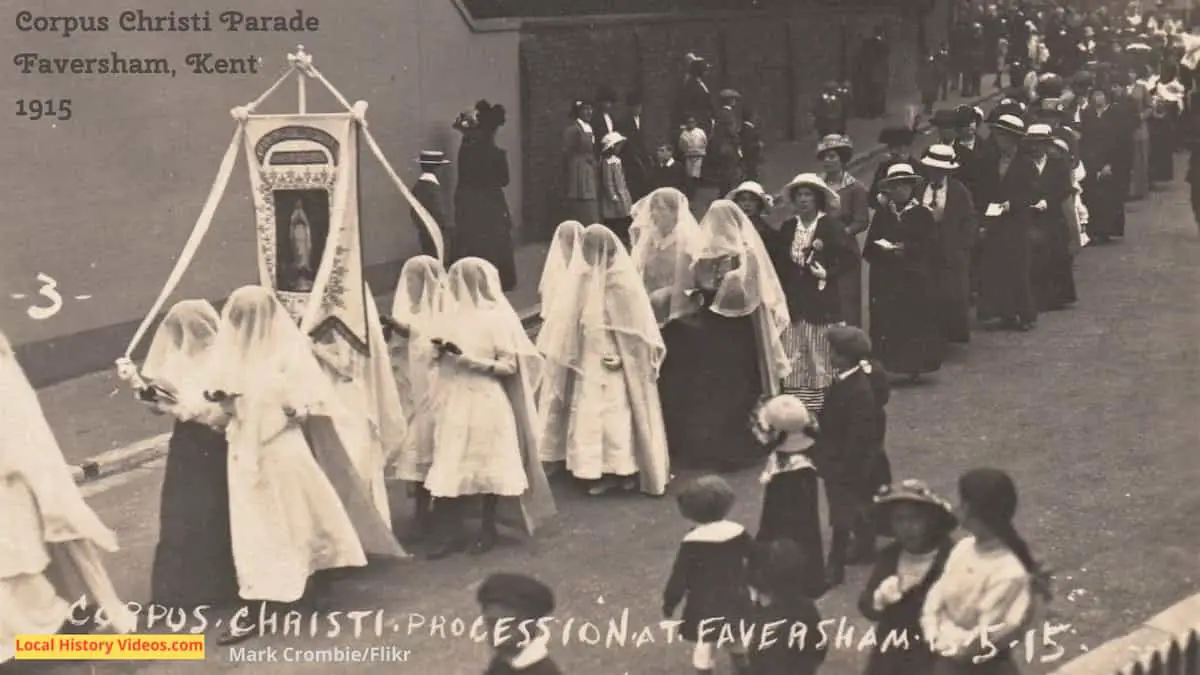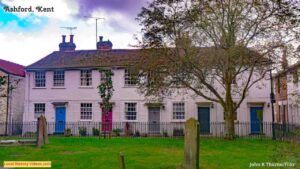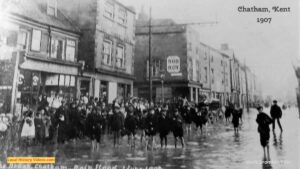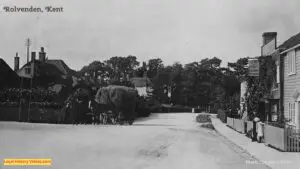Glimpse history through old images of Faversham in Kent, England.
WW1 Air Raid 1915
It’s a shame we don’t get to see the town itself in this short, silent footage, but it’s a reminder of a long forgotten event of the Great War, now known as World War I.
The purpose of the incendiary devices dropped from planes was to set fire to the buildings below.
Aftermath of air raid at Faversham (1915) – British Pathé on YouTube
Fire Brigade 1931
Whether the Jet Ball battle was for fun or charity isn’t clear. But in the background, we do see some of the nearby homes.
QUIRKY – Fire Brigade’s Jet Ball at Faversham Kent (1931) – British Pathé on YouTube
Faversham Carnival 1952
In 1952, more than 40,000 people turned out to watch the carnival procession in the dark streets.
The previous year, the charity collections had raised a total of £300!
The narrator tells us that the authorities organised orderly processions through the town many years ago, after one Guy Fawkes’ Day when lots of ‘rumpus’ meant the troops had to be called in.
All the pubs were staying open late that night.
Faversham Carnival Aka Animal Carnival (1952) – British Pathé on YouTube
Historic Book
Extract from “A visitor’s guide to Faversham” by Francis Frederic Giraud and Charles Edward Donne
Published in 1876
Pages 8 & 9
COUNTRY . The Country within easy reach of Faversham ,
is picturesque and varied . There are the very extensive
Blean Woods , and Perry Wood , on high ground , low lands
stretching out to the sea shore and undulating vales surround
ing Belmont . The lands are perhaps as fertile and highly
cultivated as any within this county . Fruit and Hop planta
tions abound .
BOTANY . Mr. Bateman in his Catalogus Plantarum circa
Faversham , ” Mr. Blackstone in his ” Specimen Botanicum , “
Mr. Jacob in his ” Planta Favershamienses , ” and Mr. Cowell
in his ” Floral Guide , ” have given a list of a number of un
common plants found here . Mr. Cowell says , that the vicinity of
Faversham is exceedingly favourable to the study of botany .
The variety of its soils and its contiguity to the sea , contribute
to the production of an ample and diversified Flora . Its
shores , its chalky districts , its sandy and gravelly soils , and the
occasional tracts of Marsh land which it presents , being each
characterized by distinct vegetable productions .
DISTANCE . – Faversham is distant 47 miles from London ,
9 from Canterbury , and 6 from the Sea Coast . It is on the
London , Chatham and Dover Railway Main Line ; and is a
Junction Station to Whitstable , Herne Bay , Margate and
Ramsgate .
STREETS .– The four older and principal streets form an
irregular cross , in the centre of which stand the Market Place
and Guildhall .
MANUFACTURES . – The chief manufacture is that of Gun
powder . The Mills of Messrs . John Hall and Son cover a
wide extent of ground , and are contiguously in six different
parishes . The works were first established in the reign of
Queen Elizabeth . They were purchased by the Board of
Ordnance from Mr. John Pearse , about the year 1760 , and sold
by them in 1825 ; the whole soon after became the pro
perty of Mr. John Hall , from whom the present firm
” John Hall and Son ” is derived . The Works have since
been considerably extended and improved by the present
owners .
The Works of the Patent Cotton Gunpowder Company ,
Limited , have lately been erected on the shore of the Swale ,
in Oare Parish .
There are two extensive and old established Breweries in
Court Street , belonging to Messrs . Shepherd , Neame , & Co. ,
and Messrs . W. E. and J. Rigden .
The principal Brickfields are in Kingsfield , the Abbey
Fields , and Davington .
On the banks of the Creek are Portland and Roman
Cement and Plaster of Paris Works ; a large Steam Flour
Mill ; Builders ‘ and Shipwrights ‘ Yards ; Timber and Coal
Wharves ; Hoymen’s Wharves , and Storehouses , & c .
PRESENT GOVERNMENT . – The Town is governed by a
Corporation of great antiquity , now regulated by the Muni
cipal Corporations Acts ; and by Pavement Commissioners
appointed under an Act 29 , Geo . III .
The Borough contains an area of 550A . 2R . 5 P. The
Corporation consists of a Mayor , Four Aldermen , and
Twelve Councillors . There is also a Court of Quarter
Sessions , and a Bench of Magistrates consisting of the
Mayor , the Recorder , the ex – Mayor , and six others selected
by the Lord Chancellor .
The Pavement Commissioners act as the Urban Sanitary
Authority of the Town , and comprise the Members of the
Council , and Members chosen by the Commissioners them
selves . Their jurisdiction embraces the Borough area and a
part of Preston Street beyond .
POLICE . The Borough Police Force consists of a Head
Constable , a Sergeant , and six other Constables .
POPULATION .– At the census taken in 1871 there were
1534 inhabited houses , and 7921 persons . The population
has since increased .
Page 22
The effects of Wat Tyler’s rebellion extended to the
neighbourhood of Faversham .
Levies and insurrections
were made at Dartford , on 5th June , 1381 , and the rioters
betook themselves towards Canterbury , committing great
damage , even to killing some , pulling down houses of others ,
plundering the gaols at Maidstone and Rochester , setting
free the felons who were manacled with irons there , and
perpetrating other treasons of the same kind .
John Gardener
a tailor of Faversham , met the insurgents on 10th June at
Preston , and he , with many others , entered the close of
William Makenade , assaulted him , and would have killed
him had not James de Frogenale and Thomas Seyntleger
become bail for him , to fulfil John Gardener’s requirement .
He also went with others to Lymost , in Preston , ejected
Stephen de Makenade from his land and destroyed lime
sacks and utensils found there , and so he went on to Ospringe
and commanded Richard Bertelot to pay him instantly
twenty shillings , or else he would pull down his house and
kill him , and from there he carried away wine flagons , and
other utensils .
On the same day , William Smyth of Boughton , baker , and
others , broke into a house and plundered the goods .
John
Robyn and others assaulted and nearly killed the Constable
of Boughton Hundred , and made him pay a fine ; and John
Brown , a labourer at Faversham , and his companions , pulled
down John Kateby’s house , in Boughton .
On 12th June , Roger Baldewyn , of Boughton , raised
insurrection with other malefactors , and was present aiding
and abetting , when Simon , Archbishop of Canterbury , was
murdered .
On 29th June , Henry Bongay and others assaulted Nicolas
at Crouche , at Ospringe , and compelled him to pay a ransom
of one hundred shillings .






